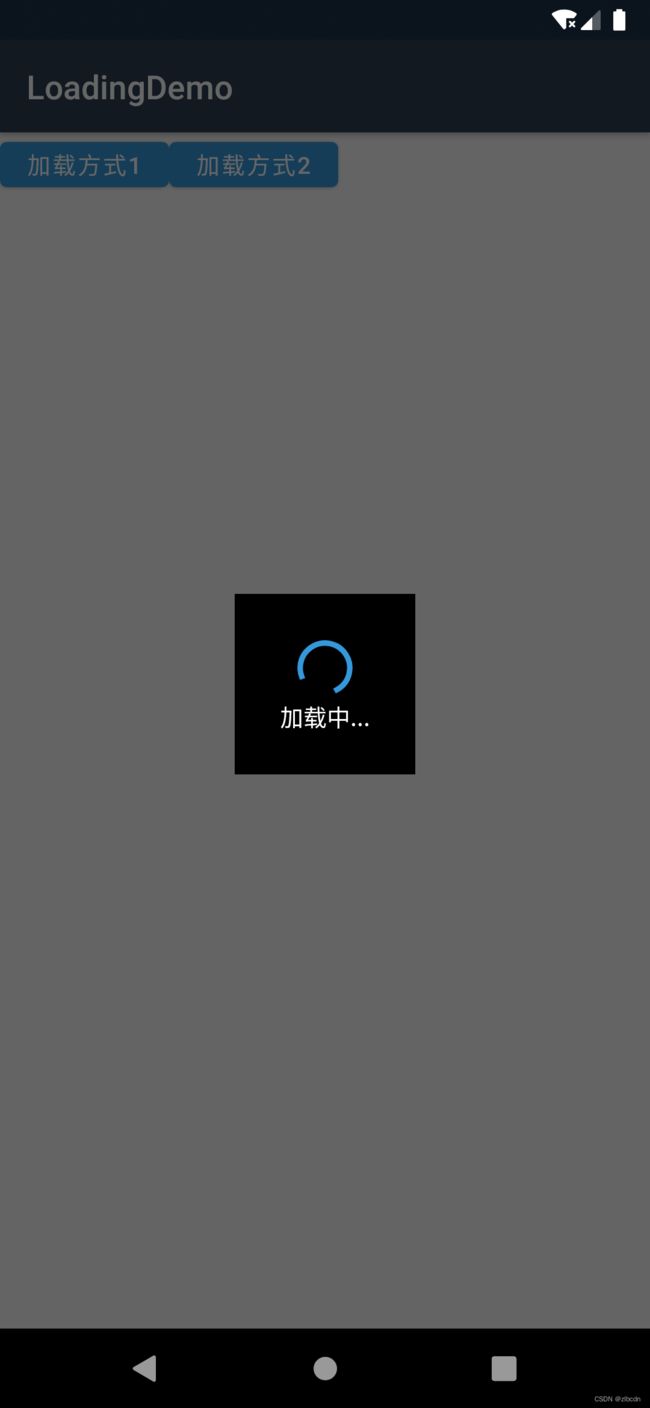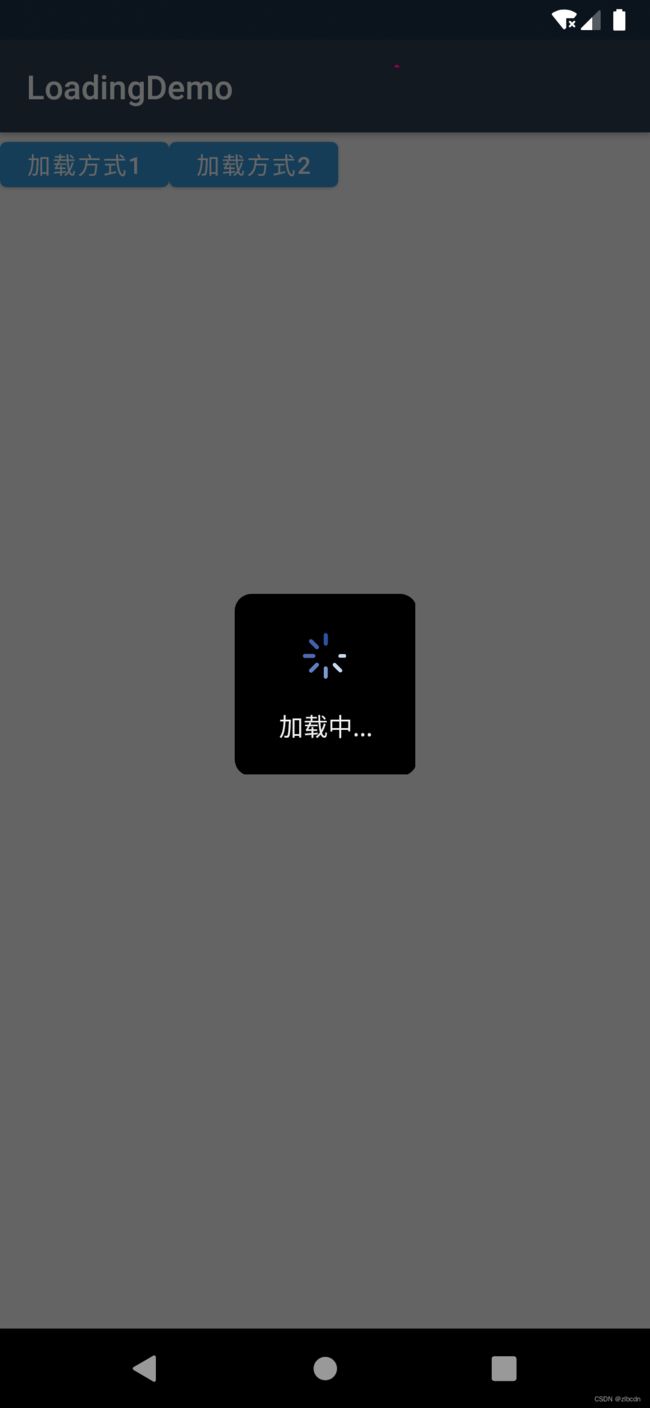Xamarin.Android实现加载中的效果
目录
- 1、说明
- 2、代码如下
-
- 2.1 图1的代码
-
- 2.1.1、创建一个`Activity`或者`Fragment`,如下:
- 2.1.2、创建`Layout`
- 2.1.3、如何使用
- 2.2 图2的代码
- 4、其他补充
-
- 4.1 C#与Java中的匿名类
- 4.2 、其他知识点
- 5、参考资料
1、说明
在实际使用过程中,常常会用到点击按钮后,系统弹出加载中画面的需求,因此整理了一下Xamarin.Android中实现加载的功能,效果如下:


2、代码如下
2.1 图1的代码
2.1.1、创建一个Activity或者Fragment,如下:
public class BaseAcitivity : Activity, IDialogInterfaceOnKeyListener
{
public Android.App.AlertDialog alertDialog;
protected override void OnCreate(Bundle savedInstanceState)
{
base.OnCreate(savedInstanceState);
}
//展示对话框
public void showLoadingDialog()
{
alertDialog = new Android.App.AlertDialog.Builder(this).Create();;
alertDialog.Window.SetBackgroundDrawable(new ColorDrawable());
alertDialog.SetCancelable(false);
alertDialog.SetOnKeyListener(this);
alertDialog.Show();
alertDialog.Window.SetLayout(300, 300);
alertDialog.SetContentView(Resource.Layout.loading_alert);
alertDialog.SetCanceledOnTouchOutside(false);
}
//退出对话框
public void dismissLoadingDialog()
{
if (null != alertDialog && alertDialog.IsShowing)
{
alertDialog.Dismiss();
}
}
//监听事件,主要是防止系统监听返回事件---悄无声息得把对话框给干没了
public bool OnKey(IDialogInterface? dialog, [GeneratedEnum] Keycode keyCode, KeyEvent? e)
{
//这儿主要是防止系统监听搜索或返回事件,造成弹框被取消
if (keyCode == Keycode.Search || keyCode == Keycode.Back)
{
return true;
}
else
{
return false;
}
}
}
Fragment同理
public class BaseFragment : AndroidX.Fragment.App.Fragment, IDialogInterfaceOnKeyListener
{
private Android.App.AlertDialog alertDialog;
public void showLoadingDialog()
{
alertDialog = new Android.App.AlertDialog.Builder(this.Context).Create();;
alertDialog.Window.SetBackgroundDrawable(new ColorDrawable());
alertDialog.SetCancelable(false);
alertDialog.SetOnKeyListener(this);
alertDialog.Show();
alertDialog.Window.SetLayout(300, 300);
alertDialog.SetContentView(Resource.Layout.loading_alert);
alertDialog.SetCanceledOnTouchOutside(false);
}
public void dismissLoadingDialog()
{
if (null != alertDialog && alertDialog.IsShowing)
{
alertDialog.Dismiss();
}
}
public bool OnKey(IDialogInterface? dialog, [GeneratedEnum] Keycode keyCode, KeyEvent? e)
{
if (keyCode == Keycode.Search || keyCode == Keycode.Back)
{
return true;
}
else
{
return false;
}
}
}
2.1.2、创建Layout
即Resource.Layout.loading_alert,代码如下:
<?xml version="1.0" encoding="utf-8"?>
<LinearLayout xmlns:android="http://schemas.android.com/apk/res/android"
android:layout_width="match_parent"
android:layout_height="match_parent"
android:orientation="vertical"
android:gravity="center"
android:background="#000">
<ProgressBar
android:id="@+id/progressBar1"
android:layout_width="40dp"
android:layout_height="40dp"
android:layout_centerHorizontal="true"
android:layout_centerVertical="true"
android:layout_gravity="center_horizontal"
style="@style/AppTheme.NoActionBar"
/>
<TextView
android:text="加载中..."
android:textAppearance="?android:attr/textAppearanceSmall"
android:layout_width="wrap_content"
android:layout_height="wrap_content"
android:textColor="@android:color/white"
android:id="@+id/textView1" />
</LinearLayout>
代码比较简单,只不过在ProgressBar用到了一个style,—AppTheme.NoActionBar。其代码如下:
<style name="AppTheme.NoActionBar">
<item name="android:windowActionBar">false</item>
<item name="android:windowNoTitle">true</item>
</style>
2.1.3、如何使用
创建一个新的Activity或者Fragment时,继承上面的两个基类
例如:
public class MineFragment : BaseFragment
然后在子类中直接使用:
private void DataUpdateBtn_Click(object sender, EventArgs e)
{
base.showLoadingDialog();
Task.Factory.StartNew(() => {
//同步字典数据
//具体业务操作代码
//TO-DO
//关闭对话框
base.dismissLoadingDialog();
});
}
即可实现
2.2 图2的代码
相比较图1,图2在具体实现上基本没有差别,仅有的差别就是在Layout上,图2的Layout如下:
<?xml version="1.0" encoding="utf-8"?>
<LinearLayout xmlns:android="http://schemas.android.com/apk/res/android"
android:padding="10dp"
android:layout_width="110dp"
android:layout_height="110dp"
android:background="@drawable/corners_bg" <!--差别1:主要是实现了圆角-->
android:gravity="center"
android:orientation="vertical" >
<ProgressBar
android:id="@+id/progressBar1"
android:layout_width="35dp"
android:layout_height="35dp"
android:layout_gravity="center_horizontal"
android:indeterminateBehavior="cycle"
android:indeterminateDrawable="@drawable/dialog_loading" <!--差别2:使用了自定义的图片-->
android:indeterminateOnly="true" />
<TextView
android:id="@+id/tipTextView"
android:layout_width="wrap_content"
android:layout_height="wrap_content"
android:layout_marginTop="15dp"
android:text="加载中..."
android:textColor="#f0f0f0"
android:textSize="15sp" />
</LinearLayout>
corners_bg.xml定义如下:
主要是实现圆角功能
<?xml version="1.0" encoding="utf-8" ?>
<shape xmlns:android="http://schemas.android.com/apk/res/android">
<solid android:color="#000" />
<corners android:topLeftRadius="10dp"
android:topRightRadius="10dp"
android:bottomRightRadius="10dp"
android:bottomLeftRadius="10dp"/>
</shape>
dialog_loading.xml定义如下:
<?xml version="1.0" encoding="utf-8"?>
<animated-rotate xmlns:android="http://schemas.android.com/apk/res/android"
android:drawable="@mipmap/loading"
android:pivotX="50%"
android:pivotY="50%" />
主要是使用了自定义的图片,以及图片旋转时的参数
4、其他补充
4.1 C#与Java中的匿名类
在网上的例子中,常常可以看到如下的代码:
alertDialog.setOnKeyListener(new DialogInterface.OnKeyListener() {
@Override
public boolean onKey(DialogInterface dialog, int keyCode, KeyEvent event) {
if (keyCode == KeyEvent.KEYCODE_SEARCH || keyCode == KeyEvent.KEYCODE_BACK)
return true;
return false;
}
});
这是Java中常见的写法,在匿名类中实现方法。但这种方式无法在C#中实现,因为C#的匿名类中只能包含字段(field),C#的匿名类型是由一个或多个公共只读属性组成的类类型。 不允许包含其他种类的类成员(如方法或事件)。 匿名类型不能强制转换为除 object 以外的任何接口或类型。
官网的说明如下:
Anonymous types contain one or more public read-only properties. No other kinds of class members, such as methods or events, are valid.
It is also possible to define a field by object of another type: class, struct or even another anonymous type.
为啥Java可以,C#不可以呢。主要原因就是C#有委托(delegate)。 因此,在Java中,如果我们想实现事件机制或者传一个方法,一般是使用接口。那么定义一个类去实现接口是多么麻烦的事情。 你在Java中能看到大量的只有一个方法的接口,比如Runnable。 而C#已经有了匿名委托了,使用委托比使用接口更简单,没必要再画蛇添足了。 事实上Java饶了弯路,它们现在也开始支持Lambda表达式,而且还不得不出于兼容的考虑,创造了一个雌雄同体的怪异语法约定——那种只有一个方法的接口,可以用Lambda表达式表示
4.2 、其他知识点
在整个过程中,用到的知识就是ProgressBar和Handler接口
5、参考资料
1、Android最简单的LoadingDialog
2、C# 匿名类